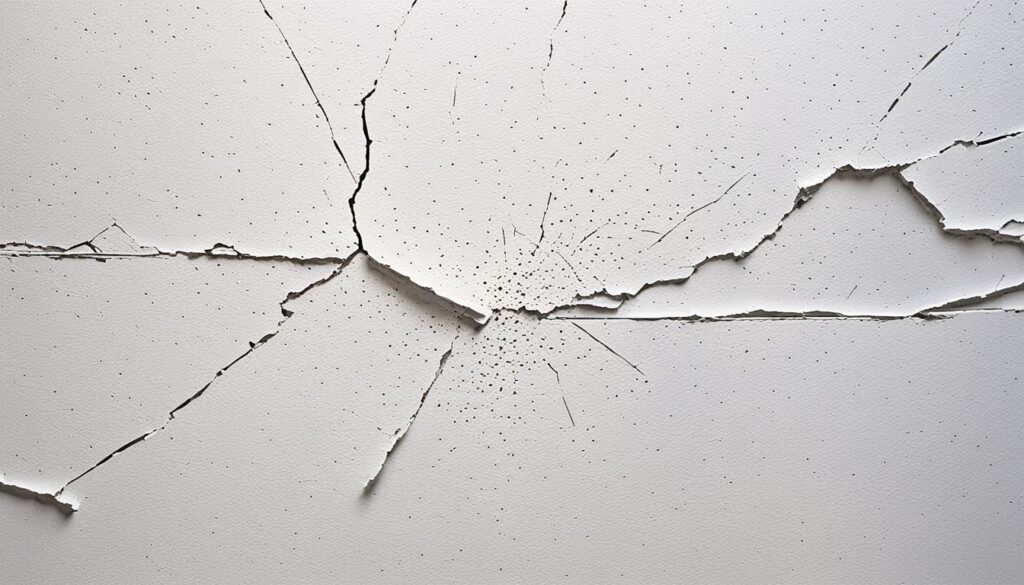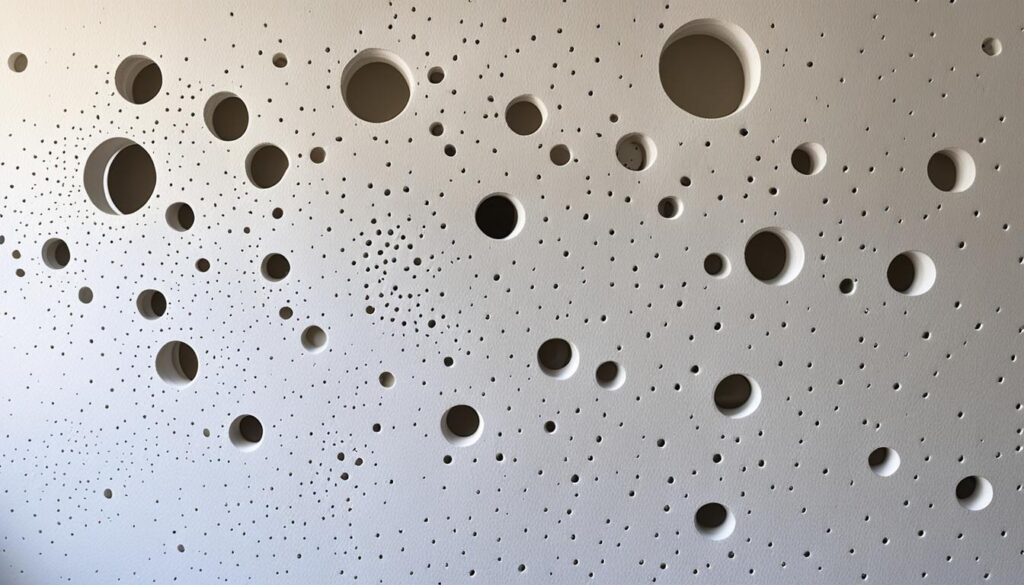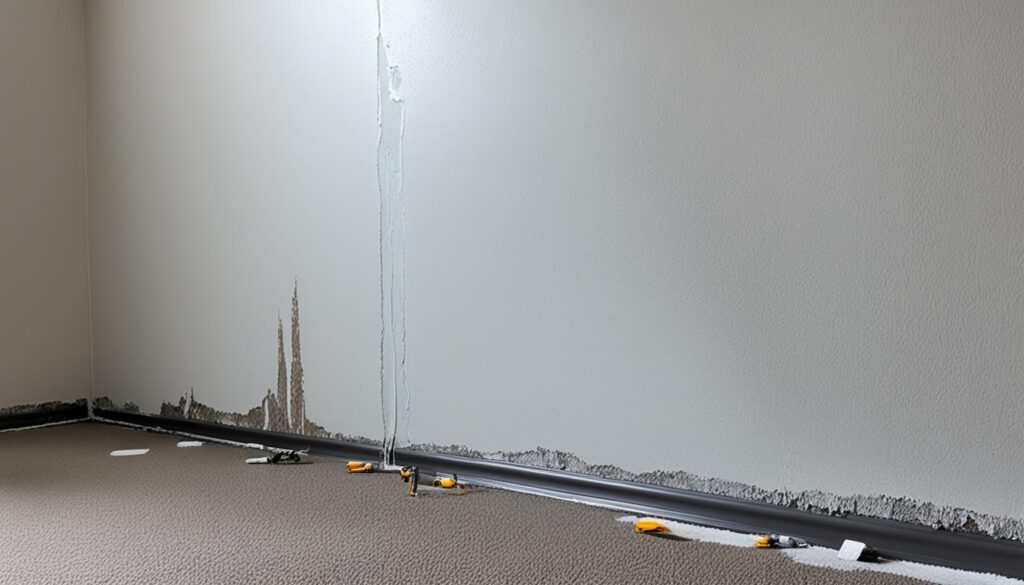
Drywall is vital in our homes, giving strength and a smooth look to walls and ceilings. Over time, it can get damaged and need replacing. Knowing the signs of drywall damage is key to keeping your home safe and attractive.
Holes, cracks, and water damage are clear signs your drywall might need replacing. Accidents or pests cause holes. Repairing them, especially big ones, can be tough. Cracks might show issues with how it was installed, temperature changes, or water damage. Water damage is a big problem. It can cause mold, weaken your home’s structure, and could be risky to health.
Spotting these signs early can save you a lot of trouble. Replacing drywall needs the right tools and can be expensive and take time. But, there’s an easy-to-install, durable, and water-resistant option: Trusscore Wall&CeilingBoard. It’s made of PVC and is a strong choice for your drywall needs.
Key Takeaways:
- Drywall damage signs include holes, cracks, and water damage.
- Holes can be caused by accidents or pests and may require professional attention.
- Cracks in drywall may indicate underlying structural issues or water damage.
- Water damage can lead to mold growth and compromise the integrity of your home.
- Replacing damaged drywall can be time-consuming and costly, but Trusscore Wall&CeilingBoard offers a durable alternative.
Holes in Drywall

Drywall can get holes for many reasons. This includes things like bumping into it, moving furniture, and even bugs. Fixing small holes is pretty simple. Just use stuff you probably already have at home. You can fill these holes in with spackle or joint compound. Then, sand it until it’s smooth. But, big holes or ones that go all the way through are harder to repair. You might have to remove and put new drywall in their place.
Repairing drywall depends a lot on the hole’s size. Small holes from nails or screws are easy to hide. For bigger holes, covering them might not be enough to make your wall look good again. You could need to change the whole piece of drywall.
The steps for fixing big drywall holes are:
- Cut out the broken drywall using a utility knife or saw.
- Measure and cut a new piece to fit.
- Screw the new piece onto the wall’s studs.
- Then, smooth out the seams with tape and mud.
- Lastly, sand it again and paint it to match the wall.
Remember, fixing or swapping drywall might need a pro. Especially if it’s a big job. Drywall pros have the right skills and tools. They make sure your wall looks good as new after.
Cracks in Drywall
Cracks in drywall are a common headache for many homeowners. They show up for various reasons. This could be due to a poor taping job, water damage, or changes in the home’s foundation. Time, temperature shifts, and humidity can also play a role. Figuring out why the cracks showed up is key to fixing them the right way.
Small cracks are usually not a big deal and can be easily fixed. You can repair through patching them. This means putting joint compound into the crack, sanding it smooth, and painting over it. Keep in mind this is often just a quick fix and might not solve the root cause.
But if you see larger cracks, they might be a sign of a bigger problem. You might have to replace the affected sections of drywall. Fixing this kind of issue is tough and usually needs a professional’s hand. They can make sure the wall stays solid and safe.
It’s a good idea to get a professional’s opinion when you see cracks in your drywall. They can look over the damage and figure out what needs to be done. Sometimes just fixing the drywall is enough. Other times, the whole section needs to be replaced.
Preventing Cracks in Drywall
While you can’t completely stop drywall cracks, there are ways to lessen the risk. Homeowners can:
- Keep the home’s humidity levels steady to cut down on drywall movement.
- Make sure drywall sheets are put up tight to the wall to avoid shifting.
- Deal with any foundation problems right away.
- Choose high-quality materials and have them installed by a pro.
Following these tips can make your drywall last longer and reduce the chance of cracks.
Water Damage to Drywall
Water damage can really mess up your drywall. It leads to problems that need quick fixes. You might see stains, discoloration, bubbling, peeling paint, and softened areas as signs of damage. This type of damage affects the strength of your walls. It’s also perfect for mold growth, which is bad for your health.
Dealing with water-damaged drywall means acting fast. Fixing it requires finding the source of the water and replacing the damaged parts. This ensures your home is safe and looks good again.
It’s smart to get help from drywall repair pros to understand how bad the damage is. They can find the real issues and do repairs that work. Experience this awesome article for yourself.
Addressing the Underlying Cause
First, you must stop the water from coming in to fix the drywall. Leaky pipes, roofs, or too much moisture are often to blame. Fixing these problems stops the damage from happening again.
Replacing Water Damaged Drywall
Usually, soaked drywall needs to be swapped out, not patched. Water weakens drywall, and mold may grow.

Replacing the drywall means taking out the wet parts and putting in new ones. It’s important to fully dry the area first. This stops any leftover water from causing more trouble.
After new drywall is up, pros will make the wall look seamless. They match the new wall to the old one to look uniform.
Preventing Future Water Damage
Once you’ve replaced damaged drywall, work to keep it from happening again. Check for leaks, keep the air moving, and fix problems quickly. Using waterproof products can also help keep moisture out.
Drywall Replacement Costs and Alternatives
When you look into replacing drywall, several things affect the cost. These include the work, the materials, and how big the project is. The average cost for materials is between $300 and $400. For labor, it can be between $40 and $100 an hour, or $30 to $70 per sheet, based on the job’s complexity.
If you decide to do the work on your own, it can take a lot of time. But there are other options besides traditional drywall. For instance, Trusscore Wall&CeilingBoard is a durable PVC-based choice that has many benefits.
Trusscore is simple to put up and fights off water and mold. This makes it perfect for places with a lot of moisture, like bathrooms and basements. But what’s really great is that you can install these panels four times faster than regular drywall. Plus, they have pre-punched screw spots, which makes putting them up even easier.
At Painting Done by Angel’s, we assist those in the Scottsdale & Phoenix, Arizona area in making their homes and offices beautiful. We offer interior and exterior painting services with 15+ years of expertise. Our family-owned and operated team is licensed and insured, ensuring that your investment is safe with us. We pride ourselves on delivering the greatest outcomes for our valued customers every time!
FAQ
What are the signs that my drywall needs to be replaced?
Signs that your drywall may need replacing are holes, cracks, and water damage. Holes can come from accidents or pests. They’re hard to fix, especially if they’re big. Cracks might point to poor work, water damage, or temperature changes.
Water damage is serious, leading to mold and health risks. Wet drywall often must be replaced to keep you safe.
How do I repair holes in the drywall?
Small holes can be filled with spackling or joint compounds. But for bigger or wall-through holes, you might need to replace the drywall. If the damage is severe, call a pro.
How do I fix cracks in drywall?
For small cracks, you can use joint compound or tape. Bigger cracks might mean bigger problems. Replacing the damaged part might be needed. Getting expert help for serious cracks is wise.
What should I do about water damage to drywall?
Water damage shows as stains, peeling paint, and soft spots. If it’s bad, replacing the drywall is safest. This prevents more damage and keeps you from health and fire risks.
It’s also key to fix the water source. This stops more damage. Fix leaks or moisture issues first.
Are there alternatives to drywall?
Yes, Trusscore Wall&CeilingBoard is a strong PVC product that’s an alternative to normal drywall. It’s durable, easy to put up, and avoids water and mold. You can install Trusscore four times faster than drywall. It comes with pre-punched screw spots, making installation easier. This alternative can save you time and money on repairs.
